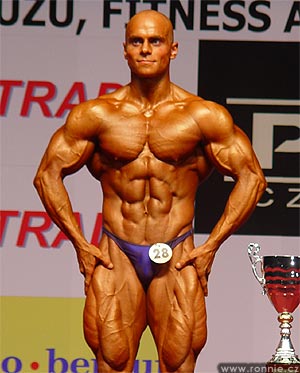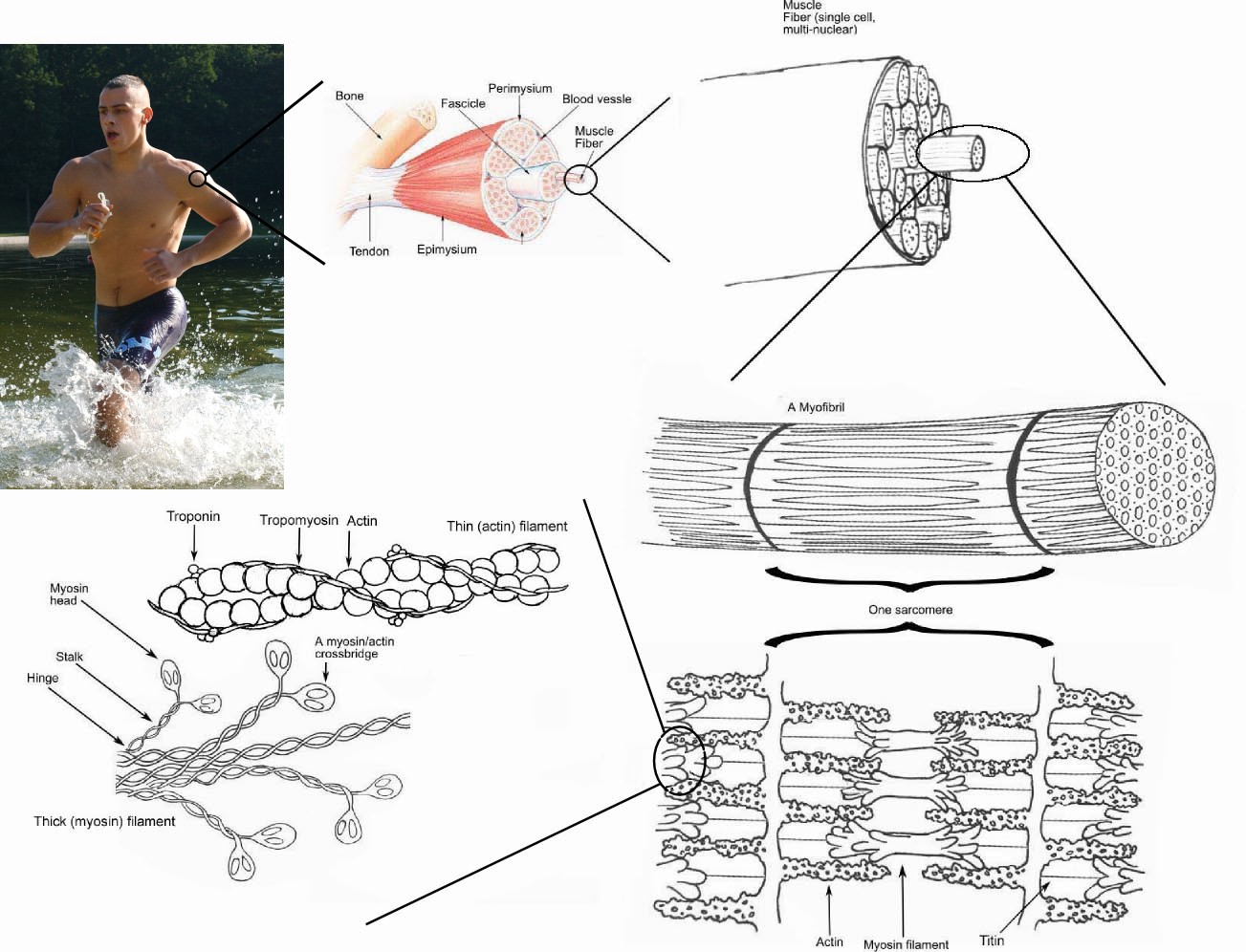Muscular hypertrophy
Muscle hypertrophy is a scientific term for the growth and increase of the size of muscle cells. It differs from muscle hyperplasia, which is the formation of new muscle cells.
Muscular hypertrophy

Several biological factors such as age and nutrition can affect muscle hypertrophy. During puberty in males, hypertrophy occurs at an increased rate. Natural hypertrophy normally stops at full growth in the late teens. Muscular hypertrophy can be increased through anabolic steroids, strength training and other short duration, high intensity anaerobic exercises. Lower intensity, longer duration aerobic exercise generally does not result in tissue hypertrophy, instead causing greater storage of fats and carbohydrates within the muscles,[1] as well as neovascularization.[2][3] Though an adequate supply of amino acids is essential to produce muscle hypertrophy and the consumption of carbohydrates and amino acids can transiently increase anabolism within muscle cells, it is not known if consuming protein immediately after exercising can result in long-term increases in muscle size.[4]
Types of hypertrophy
There are two different types of muscular hypertrophy: sarcoplasmic hypertrophy and myofibrillar hypertrophy. During sarcoplasmic hypertrophy, the volume of sarcoplasmic fluid in the muscle cell increases with no accompanying increase in muscular strength. During myofibrillar hypertrophy, the myofibrils, comprised of the actin and myosin contractile proteins, increase in number and add to muscular strength as well as a small increase in the size of the muscle.
Types of myofibrillar hypertrophy
Myofibrillar hypertrophy can, in theory, arise through two processes:
- Increase in the number of nuclei within each muscle fiber, or
- Increase in the amount of contractile material supported by each nucleus.
The latter is the usual means of muscle hypertrophy.
Strength training
Strength training typically produces a combination of the two different types of hypertrophy; contraction against 80–90%[citation needed] of the one repetition maximum for 2–8 repetitions causes myofibrillated hypertrophy to dominate (as in powerlifters, olympic lifters and strength athletes), while several repetitions (generally 12 or more) against a sub-maximal load facilitates mainly sarcoplasmic hypertrophy (professional bodybuilders and endurance athletes). The first measurable effect is an increase in the neural drive stimulating muscle contraction. Within just a few days, an untrained individual can achieve measurable strength gains resulting from "learning" to use the muscle. As the muscle continues to receive increased demands, the synthetic machinery is upregulated. Although all the steps are not yet clear, this upregulation appears to begin with the ubiquitous second messenger system (including phospholipases, protein kinase C, tyrosine kinase, and others). These, in turn, activate the family of immediate-early genes, including c-fos, c-jun and myc. These genes appear to dictate the contractile protein gene response.
Muscle hypertrophy due to strength training does not occur for everyone, and is not necessarily well correlated with gains in actual muscle strength: it is possible for muscles to grow larger without becoming much stronger.[5]
Protein synthesis
Finally, the message filters down to alter the pattern of protein expression. It can take as long as two months for actual hypertrophy to begin.[citation needed] The additional contractile proteins appear to be incorporated into existing myofibrils (the chains of sarcomeres within a muscle cell). There appears to be some limit to how large a myofibril can become: at some point, they split. These events appear to occur within each muscle fiber. That is, hypertrophy results primarily from the growth of each muscle cell, rather than an increase in the number of cells.
Anaerobic training
Experts and professionals differ widely on the best approaches to specifically achieve muscle growth (as opposed to focusing on gaining strength, power, or endurance); it is generally considered that consistent anaerobic strength training will produce hypertrophy over the long term in addition to its effects on muscular strength and endurance. As testosterone is one of the body's major growth hormones, on average men find hypertrophy much easier to achieve than women. Taking additional testosterone as in anabolic steroids will increase results, but the psychological and physiological side-effects can cause serious health issues. It is also considered a performance-enhancing drug, the use of which can cause competitors to be suspended or banned from competitions. In addition, testosterone is also a medically regulated substance in most countries, making it illegal to possess without a medical prescription.
In order to get the best gains out of training sessions, experts agree on some basic principles, however some are contradicted by other research:
Progressive overload is considered the most important principle behind hypertrophy, so increasing the weight, reps and sets will all have a positive impact on growth. Some experts create complicated plans that play around with weight, reps and sets, increasing one while decreasing the others, to constantly shock the body into growing. Keeping the sets and reps the same while just increasing weight will lead to growth, but will focus more on developing muscular strength; keeping the weight the same but doing more sets, or doing a few extra reps, may be more effective at stimulating growth for a few weeks, before a rise in weight is necessary. It is generally believed that with more than 15 repetitions per set, the weight will be too light to stimulate growth. Also leave about 45-60sec rest between sets.
Microtrauma
Microtrauma, which is tiny damage to the fibres, is seen as the basis for hypertrophy. When microtrauma occurs (from weight training or other strenuous activities), the body responds by overcompensating, replacing the damaged tissue and adding more, so that the risk of repeat damage is reduced. This is why progressive overload is essential to continued improvement, as the body adapts and becomes more resistant to stress.
Skeletal muscle hypertrophy at a cellular level

Skeletal muscle hypertrophy is initiated by microtrauma occurring in the exercised muscle tissue. The cells that make up the tissue (myofibers) are polynucleated, gaining additional nuclei from activated satellite cells, which fuse to the already mature muscle cell. The satellite cells, and the signaling that activates them, are believed to be the secret behind muscle hypertrophy.[6] In an effort to prevent future trauma, the nuclei, whose number has increased due to the signaling created by the exercise and integration of satellite cells, increase synthesis of sarcomeric proteins, such as actin and myosin, increasing the size of the myofibrils that make up the sarcomeres contained in the muscle cell. Increased contractile proteins increase the strength of the muscle, contribute towards increased sarcomeric size and make the muscle, as a whole, look larger. Skeletal muscle cells do not divide, size increases occur only at the sarcomeric level.[7]
References
- ↑ van Loon LJ, Goodpaster BH (2006). "Increased intramuscular lipid storage in the insulin-resistant and endurance-trained state". Pflugers Arch. 451 (5): 606–16. doi:10.1007/s00424-005-1509-0. PMID 16155759.
- ↑ Soares JM (1992). "Effects of training on muscle capillary pattern: intermittent vs continuous exercise". The Journal of sports medicine and physical fitness. 32 (2): 123–7. PMID 1279273.
- ↑ Prior BM, Yang HT, Terjung RL (2004). "What makes vessels grow with exercise training?". J. Appl. Physiol. 97 (3): 1119–28. doi:10.1152/japplphysiol.00035.2004. PMID 15333630.
- ↑ Tipton KD, Wolfe RR (2001). "Exercise, protein metabolism, and muscle growth". International journal of sport nutrition and exercise metabolism. 11 (1): 109–32. PMID 11255140.
- ↑ Hubal, MJ (2005). "Variability in muscle size and strength gain after unilateral resistance training". Medicine and Science in Sports and Exercise. 37 (6): 964–972. PMID 15947721. Retrieved July 17, 2007. Lay summary – The New York Times (February 12, 2002). Unknown parameter
|month=ignored (help); Unknown parameter|coauthors=ignored (help) - ↑ Hawke TJ, Garry DJ (2001). "Myogenic satellite cells: physiology to molecular biology". J. Appl. Physiol. 91 (2): 534–51. PMID 11457764.
- ↑ Russell B, Motlagh D, Ashley WW (2000). "Form follows function: how muscle shape is regulated by work". J. Appl. Physiol. 88 (3): 1127–32. PMID 10710412.
- CS1 maint: Multiple names: authors list
- Pages with citations using unsupported parameters
- All articles with unsourced statements
- Articles with unsourced statements from January 2007
- Articles with invalid date parameter in template
- Articles with unsourced statements from March 2008
- Muscular system
- Tissues
- Physiology
- Exercise physiology